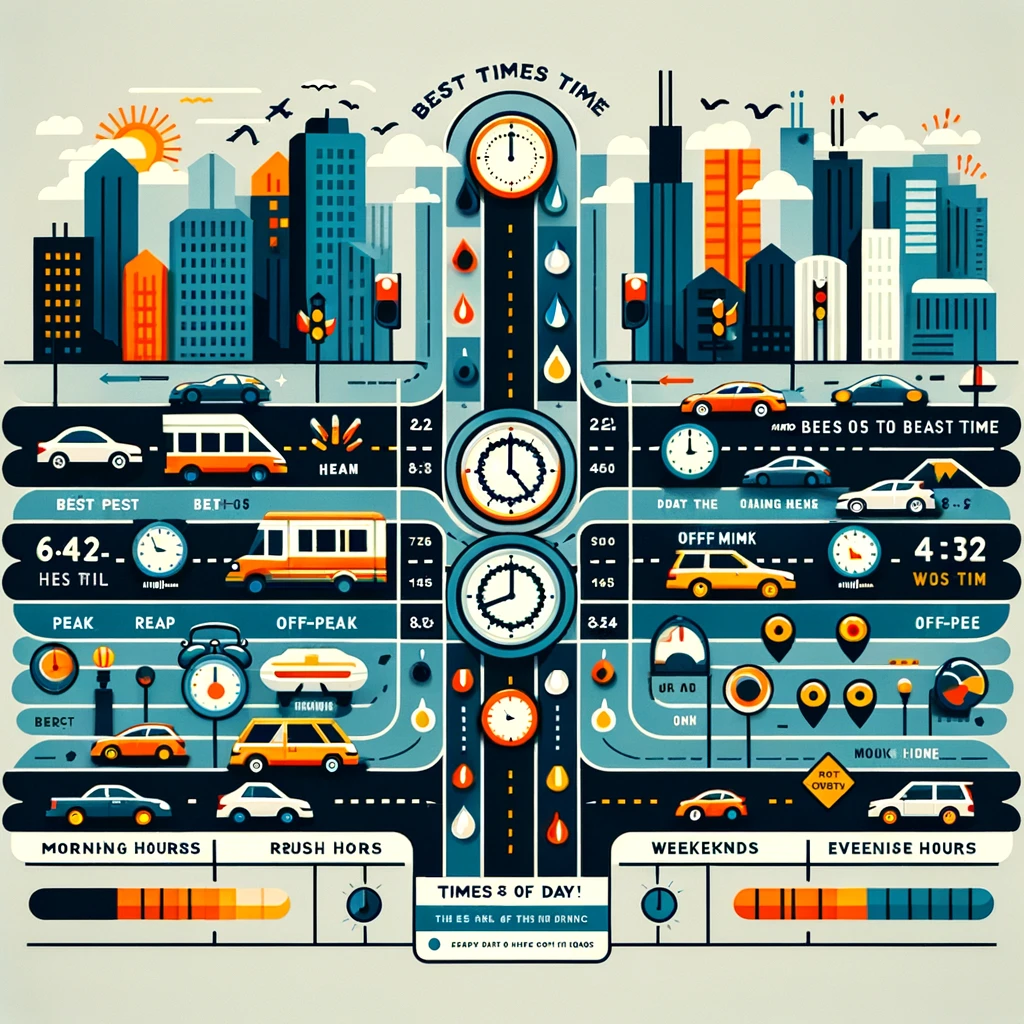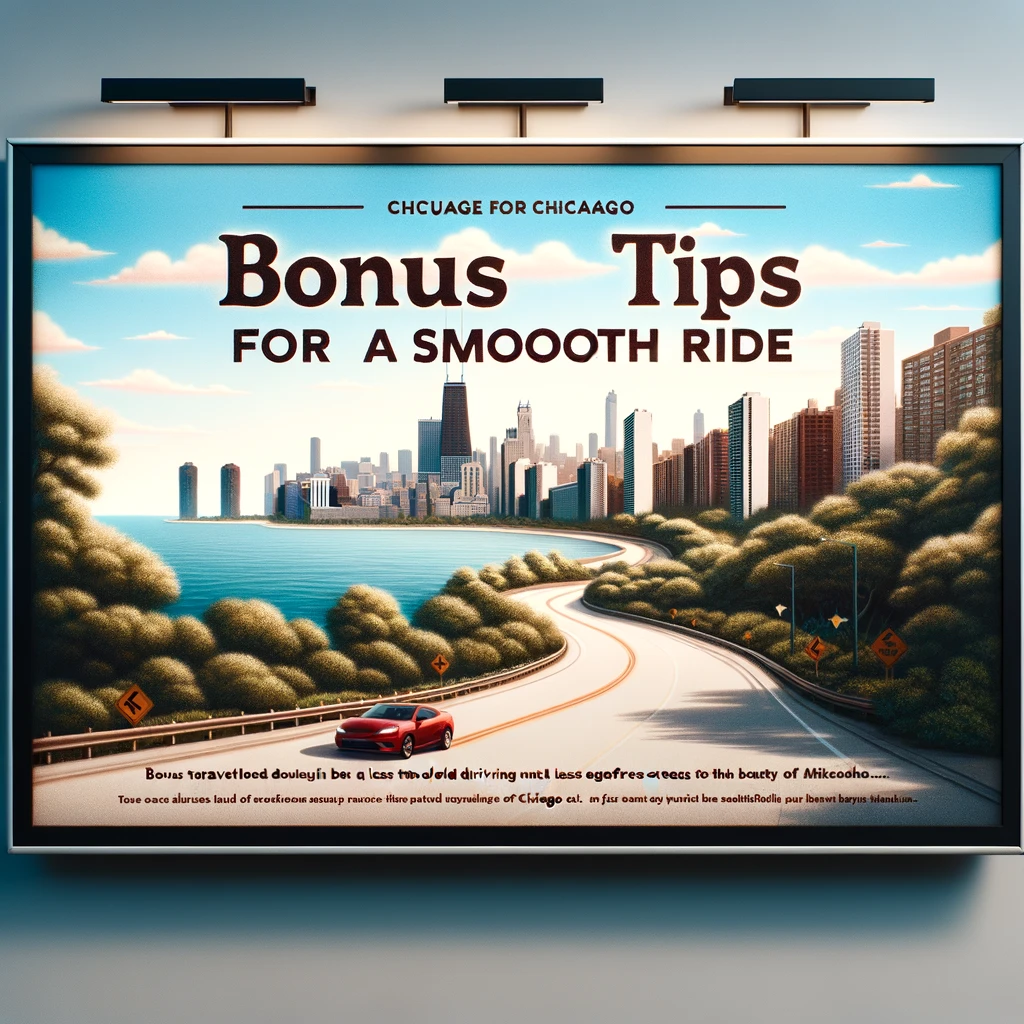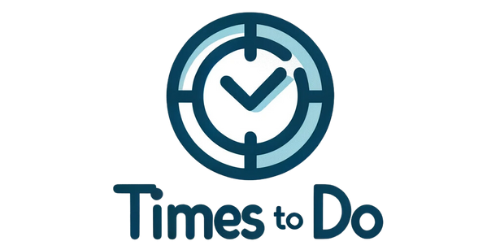The best time to drive through Chicago in 2024 (Guide for locals and Tourists)

Driving through Chicago, with its iconic skyline and vibrant cultural tapestry, offers an experience as enriching as it is complex. The city’s bustling streets and unpredictable weather patterns pose unique challenges to drivers, underscoring the importance of timing your journey wisely. This guide focuses on pinpointing the best time to drive through Chicago, equipping you with strategic insights to navigate the city more smoothly and enjoyably.
Understanding the rhythm of Chicago’s traffic and weather conditions is crucial for anyone looking to explore its diverse neighborhoods and attractions without the hassle of congestion. This article sheds light on how to leverage timing to your advantage, ensuring your travels through the Windy City are as efficient as they are pleasurable.
Key to a stress-free exploration of Chicago is recognizing the significance of timing. This piece will delve into the city’s traffic patterns, the external factors that impact them, and offer targeted advice to help you identify the most favorable driving times. Our goal is to enhance your driving experience, transforming potential challenges into an effortless journey through Chicago’s streets.
Navigating the Intricacies of Chicago’s Traffic
Chicago, the vibrant heart of the Midwest, presents a complex tapestry of roads and expressways, bustling with activity and brimming with the challenges of urban navigation. As drivers weave through the city’s streets, understanding the ebb and flow of its traffic becomes crucial.
Here, we delve into the present-day hurdles drivers face and highlight the key influences on Chicago’s traffic dynamics, offering insights for a more manageable journey through the city. For up-to-date traffic information and road closures, you can visit the Illinois Department of Transportation website: https://idot.illinois.gov/.

Current Traffic Challenges
In a city as sprawling and dynamic as Chicago, traffic congestion is a given. The daily rush hours transform the city into a slow-moving sea of vehicles, with mornings and evenings witnessing significant slowdowns. These periods of heavy traffic are not just time-consuming but also test the patience and skill of even the most seasoned drivers.
Influential Factors on Traffic Flow
Several key factors play pivotal roles in shaping the flow of traffic in Chicago, affecting everything from daily commutes to leisurely drives across the city:
- Weather Conditions: Chicago’s weather is famously unpredictable, with harsh winters and humid summers. Snow, ice, and rain frequently impact driving conditions, leading to slower traffic and necessitating extra caution on the roads.
- Special Events: The city’s calendar is packed with events that draw locals and visitors alike. Whether it’s a major sports game, a concert, or a festival, these events often result in road closures and rerouted traffic, significantly impacting flow and requiring drivers to plan their routes more carefully.
- Ongoing Construction: Infrastructure improvements and maintenance are constant in Chicago, leading to unexpected delays and detours. Staying updated on construction activity can help drivers avoid getting caught in common traffic snarls.
By keeping these factors in mind, drivers can better anticipate and navigate the complexities of Chicago’s traffic. While the city’s bustling streets may sometimes challenge, armed with the right knowledge, motorists can enjoy smoother travels and fully embrace the energy and excitement of Chicago.
best time to drive through Chicago

Morning Rush Hour Dynamics
The morning rush hour in Chicago typically starts around 6:30 AM and lasts until 9:30 AM. During these hours, commuters flood the roadways, leading to heavy traffic congestion. If you want to avoid the morning rush, consider leaving before 6:30 AM or after 9:30 AM. These time slots generally offer a more relaxed driving experience, allowing you to enjoy your morning coffee without the stress of bumper-to-bumper traffic.
Evening Rush Hour Strategies
Chicago’s evening rush hour kicks off around 3:30 PM and continues until 6:30 PM. This is another period when traffic congestion can be a real headache. If your schedule allows, try to hit the road either before 3:30 PM or after 6:30 PM. These time slots usually provide a smoother ride and a chance to admire the city’s skyline without the constant brake lights in your view.
Weekend and Holiday Traffic Patterns
Weekends and holidays in Chicago can be a mixed bag when it comes to traffic. On one hand, the reduced volume of commuters can make for a more pleasant drive. On the other hand, tourists flock to the city, and special events can cause road closures and detours.
Planning ahead is crucial during weekends and holidays. Check for any major events or festivals happening in the city, as they can impact traffic significantly. Consider using traffic apps like Waze or Google Maps to navigate through potential roadblocks and congestion.
Escape the Expressway Gridlock
Ditch the congested Dan Ryan or Kennedy during peak hours. Explore less-traveled stretches like I-290 or scenic byways like Lake Shore Drive. For north-south commutes, consider alternative routes like Cicero Avenue or Archer Avenue.
Seasonal and Holiday Traffic Variations

Merging insights on the fluctuations of traffic through the seasons with recommendations for the best times to traverse Chicago, we present a streamlined table. This reference distills essential advice on circumventing the hurdles presented by each season, offering strategic insights for a smoother journey.
By succinctly mapping out the challenges and optimal timings for driving, this guide serves as a handy navigator through the city’s ever-changing traffic landscape, ensuring that your travel plans align with the rhythms of Chicago’s streets.
| Season/Holiday | Key Traffic Challenges | Best Times for Driving | Navigational Tips |
|---|---|---|---|
| Spring | Wet roads; Increased events | Late morning to early afternoon | Monitor forecasts and event calendars; Sidestep rush hours |
| Summer | Street fairs; Ongoing construction | Late morning; Weekend mornings | Prepare for detours; Keep up with event announcements |
| Autumn | School traffic; Shorter days | Late morning; Before sunset | Enhance vehicle visibility; Plan routes avoiding school zones |
| Winter | Snowy conditions; Limited daylight | Midday when sunlight is optimal | Drive cautiously; Allocate extra time for travel |
| Holiday Seasons | Surge in travel; Special events | Early morning; Late night | Avoid high-traffic days; Use traffic apps for updates |
By consulting this table, drivers can gain foresight into the seasonal nuances affecting Chicago’s roads and make informed decisions to evade potential traffic snarls. Embracing these strategies ensures not just a safer journey but also a more pleasant and efficient exploration of the city, irrespective of the season or occasion.
Holiday Hustle
Thanksgiving and Christmas weekends turn highways into parking lots. Plan your trip around these dates, or embrace public transportation or Amtrak for a stress-free journey.
Festival Frenzy
Major events like Lollapalooza or Taste of Chicago draw massive crowds and significant congestion. Check festival calendars and plan detours well in advance, or consider adjusting your travel dates to avoid the chaos.
Navigating Through Chicago: Essential Driving Techniques
Navigating through Chicago’s bustling streets and dynamic traffic patterns requires a blend of preparation, insight, and flexibility. Below, we focus on key strategies designed to facilitate a smoother driving experience in the Windy City, emphasizing strategic route planning, adapting to the city’s varied traffic flow, and leveraging modern technology.

Strategic Route Planning
The cornerstone of a hassle-free drive through Chicago lies in thoughtful route planning. With the advent of advanced GPS and traffic management apps, drivers have the power to navigate the city’s complexities more efficiently than ever. These tools not only suggest the quickest paths but also offer real-time updates on congestion, road closures, and alternate routes, helping you steer clear of potential delays.
Leveraging Local Insights
Tapping into the wisdom of Chicago’s seasoned commuters can unlock a treasure trove of navigation tips. Engaging in community forums or conversing with locals may reveal shortcuts and time-saving routes that aren’t immediately apparent on maps or apps. These personal recommendations can often lead to discovering the most effective ways to circumvent traffic snarls.
Adapting to Time-Specific Traffic Flows
Understanding and adapting to the fluid nature of Chicago’s traffic at different times of the day can significantly enhance your driving experience:
- Morning Commute: Aim for efficiency during these hours. If possible, adjust your schedule to avoid the thickest crowds. Utilizing carpool options or public transport can also ease your journey.
- Afternoon Rush: Try to schedule errands or meetings outside the afternoon peak hours. For parents managing school pickups, consider setting up a carpool rotation to minimize the number of cars on the road.
- Evening Ease: Post-6:30 PM marks a decline in traffic volume, making it an excellent time to enjoy the city’s offerings. Whether heading out for dinner or exploring Chicago’s attractions, the evening provides a calmer driving atmosphere.
By embracing these techniques—strategic planning, local insight, and time-of-day adaptation—drivers can navigate Chicago’s streets with greater ease and confidence. These strategies not only contribute to a more pleasant driving experience but also help in appreciating the vibrant life and scenery that Chicago has to offer, without the stress of navigating its notorious traffic.
Monthly Guide to Driving in Chicago: Seasonal Overview
Chicago’s driving conditions vary dramatically with the seasons, each presenting unique challenges and strategies for safe navigation. Here’s a condensed guide to what drivers can expect month-by-month:

Winter (January – March)
- Challenges: Slippery roads from snow and ice, vehicle corrosion due to road salt, reduced daylight.
- Best Practices: Install winter tires for improved traction, drive more slowly to maintain control, keep an emergency kit in your vehicle, regularly check and maintain your battery.
Spring (April – June)
- Challenges: Increased rainfall leading to reduced visibility and slick roads, the start of construction season causing detours and delays, localized flooding.
- Best Practices: Adjust speed for wet road conditions to avoid hydroplaning, monitor traffic reports for construction updates, steer clear of flooded roadways.
Summer (July – September)
- Challenges: Elevated traffic around tourist attractions, numerous events and festivals leading to road closures, high temperatures stressing vehicle cooling systems.
- Best Practices: Time visits to tourist sites during less busy hours, stay informed about local events to plan routes, ensure your vehicle’s cooling system is functioning properly, carry water for hydration.
Autumn (October – December)
- Challenges: Increased traffic from school sessions, more vehicles on the road due to holiday shopping, slippery conditions from fallen leaves.
- Best Practices: Be mindful of speed limits and pedestrians in school zones, consider off-peak hours for shopping trips, exercise caution when driving on roads covered with wet leaves for added traction.
These seasonal driving tips offer strategies for adapting to Chicago’s varied climate and events throughout the year, ensuring a safer and more pleasant journey.
Navigating Construction and Parking in Chicago
Chicago’s dynamic landscape often presents two common challenges for drivers: navigating through construction zones and finding convenient parking. Mastering these aspects can significantly enhance your driving experience in the city.

Construction Conquerors
Dealing with construction is an inevitable part of driving in Chicago. However, with some preparation and the right tools, you can easily conquer these obstacles.
Construction Conundrums:
Always check for construction updates before hitting the road. Online resources like IDOT’s “Get Traffic Wise” or WGN-TV’s traffic map offer real-time information on construction zones and closures. Be proactive and plan alternate routes or account for potential delays.
Detour Detectives:
Apps like Waze or Google Maps are indispensable for real-time traffic updates and closure information. Stay flexible and be ready to adjust your route as needed.
Parking Panic? Not on Your Watch
Finding parking in Chicago doesn’t have to be a stressful endeavor. Whether you’re seeking street parking in bustling neighborhoods or need a spot in popular areas like Millennium Park, there are strategies and tools that can make parking hassle-free.
Street Sleuths
Neighborhoods like Lincoln Park, West Loop, or Wicker Park offer ample street parking, especially during off-peak hours. Apps like SpotHero or ParkWhiz can be a lifesaver for finding real-time garage availability and pricing.
Pre-book Peace
For popular destinations like Millennium Park or Navy Pier, consider booking your parking spot in advance. When heading downtown, especially during weekends or major events, public transportation might be a more convenient option.
Bonus Tips for a Smooth Ride

Winter Warriors: Be prepared for Chicago’s notorious winters. Pack an ice scraper and stay updated on weather forecasts for potential snowstorms or icy conditions. Adjust travel times as necessary and consider public transportation during severe weather.
Daylight Detectives: With shorter days in winter, plan your journey to avoid driving in the dark on unfamiliar roads.
Pit Stops Worthwhile: Take breaks at scenic spots like Sheridan Road or cultural landmarks like Oak Park’s Frank Lloyd Wright architecture. Discover hidden gems like Garfield Park Conservatory or the vibrant ethnic neighborhoods of Lincoln Square.
Local Knowledge: The Chicago Parking Authority app is a valuable resource for real-time parking regulations and updates. Familiarize yourself with street signs and parking restrictions to avoid fines.
Beyond the Basics
- Public Transportation: For shorter distances within the city, especially during rush hour or major events, the CTA’s network of buses and trains is an efficient alternative.
- Stay Charged: Keep a portable phone charger handy to ensure your navigation tools are always ready.
- Offline Maps: Download offline maps for areas with limited internet access, ensuring you’re never lost.
- Snacks and Drinks: Pack some refreshments for longer journeys or in case of unexpected delays.
- Stay Calm: Chicago traffic can be unpredictable. Keep calm, be patient, and enjoy the unique atmosphere of the city.
Product Recommendations for a Better Driving Experience
To enhance your driving experience in Chicago, consider investing in a few key products and accessories. These recommendations will help you navigate the city with ease and convenience:

Traffic Apps
Download traffic apps like Waze or Google Maps to receive real-time traffic updates and alternative routes. These apps can provide invaluable information about accidents, road closures, and traffic congestion.
Dash Cam
A dash cam can provide evidence in case of accidents and help you navigate tricky insurance claims. It’s a valuable tool for documenting your journeys and ensuring your safety on the road.
Phone Mount
A secure phone mount allows you to use navigation apps safely while keeping your hands on the wheel. It helps you stay connected without compromising safety.
Bluetooth Hands-Free Kit
Stay connected without taking your hands off the wheel with a Bluetooth hands-free kit. It allows you to make and receive phone calls while keeping your focus on driving.
Emergency Kit
Carry an emergency kit with essentials like first-aid supplies, blankets, and non-perishable snacks, especially during winter. You never know when you might need these items in an unexpected situation.
Concluding Insights: Navigating Chicago with Confidence
In concluding, we see how crucial timing and informed planning are for smoothly navigating Chicago’s vibrant streets. Armed with insights into traffic patterns, tactical driving recommendations, and digital tools for optimizing your journey, you’re better positioned to experience the city’s rich cultural and architectural marvels, whether as a resident or a visitor. These guidelines aim to enhance your navigational ease across Chicago’s diverse landscapes.
With the knowledge from this guide, you’re ready to confidently tackle the Windy City’s roads. Embrace your adventures in Chicago with enthusiasm and preparedness, looking forward to safe and enriching travels through its multifaceted allure.
Heading to Atlanta next? We’ve got you covered – see our guide Best Time to Drive Through Atlanta In 2024: Navigating Traffic
FAQs – Navigating Chicago’s Traffic
What is the best day of the week to drive through Chicago?
Generally, mid-week days like Tuesday and Wednesday tend to have lighter traffic compared to Mondays and Fridays. However, traffic patterns can vary, so it’s essential to check real-time traffic updates before your journey.
What time does rush hour start in Chicago?
Morning rush hour in Chicago typically begins around 6:30 AM and lasts until 9:30 AM. The evening rush hour starts around 3:30 PM and continues until 6:30 PM. These times can vary, so it’s advisable to check traffic updates for the most accurate information.
Is it easy to drive in Chicago?
Driving in Chicago can be challenging due to heavy traffic, unpredictable weather, and road construction. However, with careful planning, the use of navigation apps, and local insights, you can navigate the city more comfortably.
What time is there less traffic in Chicago?
To experience less traffic in Chicago, aim to drive during non-peak hours, typically early in the morning (before 6:30 AM) or late in the evening (after 6:30 PM). Weekdays tend to have lighter traffic than weekends.
What is the best route to avoid in Chicago?
Several routes in Chicago are notorious for traffic congestion, such as the Kennedy Expressway (I-90/94) and the Dan Ryan Expressway (I-90/94). To avoid congestion, use traffic apps to find alternative routes or consider taking surface streets.
Is driving in Chicago stressful?
Driving in Chicago can be stressful during peak hours and inclement weather. However, with the right strategies, such as avoiding rush hours and using navigation apps, you can reduce stress and have a smoother experience.
Is it difficult to drive around Chicago?
Navigating Chicago’s roads can be challenging due to its complex network of highways and local streets, as well as the city’s variable traffic patterns. Familiarizing yourself with the city’s layout and traffic conditions can make it easier to drive around.
What is the best time to travel to Chicago?
The best time to travel to Chicago largely depends on your preferences. Summer offers pleasant weather and numerous events, but it can be crowded. Spring and autumn provide milder weather with fewer crowds, while winter offers a unique experience for those who don’t mind cold temperatures.
Is Chicago a good city to drive in?
Chicago can be a good city to drive in if you plan your trips carefully, avoid peak traffic hours, and stay informed about road conditions. Having a car can provide convenience for exploring the city and its surrounding areas.
